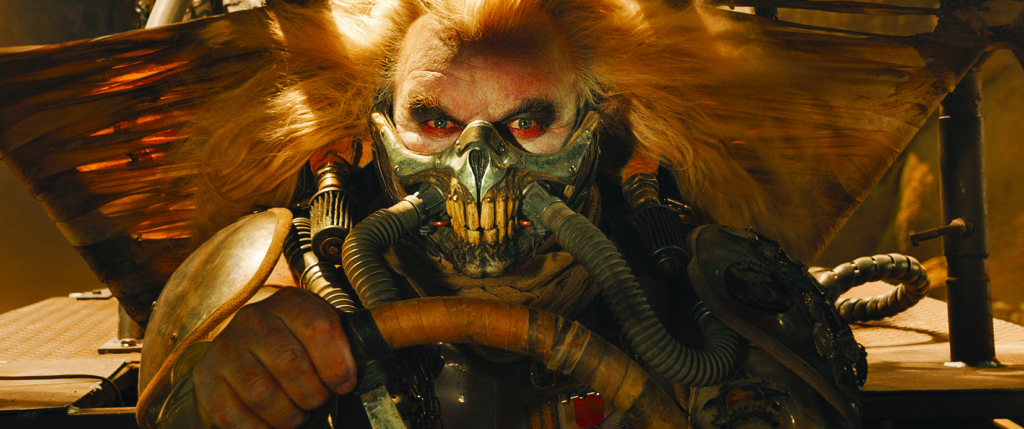George Miller’s Mad Max films collectively constitute Australia’s most successful blockbuster movie franchise. Sceptics might point to Crocodile Dundee (Peter Faiman, 1986) as competition, given its enduring cultural impact and still-unchallenged box-office dominance, but from a franchise perspective there isn’t much to debate. The Mad Max series reached its apex with 2015’s Mad Max: Fury Road, which won critics’ hearts and a bevy of Oscars; meanwhile, Crocodile Dundee’s twenty-first century revivals have been limited to the scraps of a television commercial starring Chris Hemsworth[1]See Allison Keene, ‘Shocker: The Dundee Movie with Chris Hemsworth and Danny McBride Isn’t Real’, Collider, 24 January 2018, <https://collider.com/dundee-movie-fake-danny-mcbride-chris-hemsworth/>, accessed 28 April 2021. – coincidentally, the star of the upcoming Mad Max prequel, Furiosa – and a swiftly forgotten, self-referential Amazon Prime flick.[2]In case you were wondering, I’m referring here to The Very Excellent Mr. Dundee (Dean Murphy, 2020). See Jake Wilson, ‘Hogan’s Heroes: Star Image in Dean Murphy’s The Very Excellent Mr. Dundee’, Metro, no. 207, 2021, pp. 18–21.
I digress; we’re here to talk about science, not litigate which Australian blockbuster is better. But the Dundee comparison is apt. Regardless of production pedigree, there are few other films that have managed to make such a significant international impact while feeling so unquestionably Aussie. The Mad Max franchise features mullets, Ford Falcons and a parade of Australian slang,[3]See Alex McKinnon, ‘How Mad Max: Fury Road Could Revive the World’s Fascination with Aussie Slang’, Junkee, 21 May 2015, <https://junkee.com/how-mad-max-fury-road-could-revive-the-worlds-fascination-with-aussie-slang/57223>, accessed 29 April 2021. which makes it the perfect vehicle for engaging students with science through a new context: not only do you get to explore Miller’s post-apocalyptic wasteland through a scientific lens, but you can do so without relying on the homogeneity of its Hollywood contemporaries.
Miller’s franchise – all of whose entries he directed – began in 1979 with the simply titled Mad Max. Though putatively based in a dystopian future, the first film’s minuscule budget and comparative sense of order – there are courts and police and everything – makes it seem an outlier compared to its more outlandish sequels. Those instalments – Mad Max 2: The Road Warrior (1981), Mad Max Beyond Thunderdome (1985) and the aforementioned Fury Road – amp up the apocalyptic vibe with an increasingly insane world dominated by ramshackle compounds and scrappy costumes.
In this instalment of Cinema Science, we’ll focus on these sequels. Each presents a vision of a society defined by scarcity – of fuel, primarily – and obsessed with mechanical devices. Each is dominated by wild car chases and outlandish stunts. Each has plenty to offer a Science classroom looking to explore beyond the rigid confines of the curriculum.

Precious fluids
Mad Max 2 through Fury Road all follow similar narrative arcs: our disillusioned protagonist, Max Rockatansky (Mel Gibson / Tom Hardy) is reluctantly swept into a conflict between a ragtag crew of oppressed peoples and the established power structures they are resisting. Those conflicts are driven by natural resources. In Mad Max 2,a gang called the Marauders lays siege to an oil refinery, desperate for the gasoline therein. Thunderdome again revolves around fuel, but in this instance it’s pig manure (or, more specifically, the methane gas it generates). Though Fury Road’s story doesn’t centre on any one particular resource,[4]Arguably, Fury Road’s focal point of conflict is Joe’s five ‘wives’, who are initially held hostage before being freed by Furiosa (Charlize Theron) – but unpacking the concepts of slavery and gender inequality inherent in this storyline is beyond the scope of this article! the power of its chief antagonist, Immortan Joe (Hugh Keays-Byrne), stems largely from his control of the dwindling water supply.
It’s tempting to use the Mad Max series as stimulus for a larger conversation around climate change, given its vision of a barren future bereft of natural resources.
The importance of fuel in the Mad Max universe speaks to the films’ foundation – these are car films, after all, and these revheads require ‘juice’ to operate their rigs and rides – but it’s not far removed from our own reality. Our climate-change crisis stems from humanity’s addiction to carbon-emitting fossil fuels, while oil reserves are central to many international alliances and conflicts alike. Indeed, it’s tempting to use the Mad Max series as stimulus for a larger conversation around climate change, given its vision of a barren future bereft of natural resources. That’s a reading supported by Mad Max 2 and especially Fury Road – ‘Who killed the world?’[5]See Jessica Toomer, ‘How Mad Max: Fury Road Predicts the Future Climate Change and Toxic Masculinity Have in Store for Us’, SyFy Wire, 6 April 2020, <https://www.syfy.com/syfywire/how-mad-max-fury-road-predicts-the-future-climate-change-and-toxic-masculinity-have-in>, accessed 30 April 2021. – but refuted by Thunderdome, which makes the nuclear component of this devastation unambiguous.
Given how integral production and refinement are to both Mad Max 2 and Thunderdome, budding scientists can take the opportunity to explore the science – specifically, the chemistry – of converting oil deposits or animal excrement into fuel. In Unit 1 of Chemistry, a project based around the Mad Max universe could consider the processes required to refine oil to gasoline or pig manure to methane, particularly in the context of a society stripped of many of the industrial facilities available nowadays.

By understanding the chemical processes required to render usable fuel from natural resources, students could reach judgements about the most efficient use of energy in this fictional world. How could, say, the inhabitants of the oil refinery in Mad Max 2 redesign their processes to use as little energy as possible with the tools at hand? By having an in-depth discussion of such hypothetical questions, students can then consider the significance of such conversations in the contemporary energy industry.
Then there’s the other precious fluid: water. Its impending importance is first alluded to in Thunderdome when a traveller offers to sell Max water (which proves to be tainted by radiation poisoning). That scarcity escalates in the intervening years until Fury Road, in which Immortan Joe maintains his supremacy through his control over a mountain from which he’s able to irrigate clean water. There’s a spark of an idea there – the science and geology of underwater wells, and how they might survive nuclear fallout – but admittedly one without a great deal of support from the text itself. More interesting, I’d argue, would be to examine the social impact of water scarcity (we’re straying into Geography waters here, admittedly). I vividly recall attending a science museum in my youth and seeing a ‘newspaper clipping’ from an alternative history that recorded the falling of the Earth’s last drop of water: the moment when a businessman’s shower runs dry.
I tend to side with Fury Road’s more pessimistic vision of the future, in which water scarcity leads to increasing inequality and injustice. There’s an excellent New Internationalist article that considers water scarcity through the lens of Fury Road, noting that the idea of water supply being controlled by a small number of powerful individuals or corporations is far from fanciful:
Water is proving to be a good investment for transnational companies: water stocks have outperformed all other resource and commodities stocks over the last 15 years and a growing world population creates even more demand, especially with water scarcity already on the increase.[6]Beulah Devaney, ‘What Can Mad Max Tell Us About Water Scarcity?’, New Internationalist, 29 May 2015, <https://newint.org/blog/2015/05/29/mad-max-water-scarcity>, accessed 29 April 2021.
How plausible this dark vision of a populace held hostage by tightly controlled water supply might be is a question one can address scientifically. The water cycle, a concept introduced in primary-level Science, can be expanded upon in the context of various hypotheticals, whether they be nuclear fallout or overpopulation. When it comes to dwindling natural resources, Mad Max’s future might not be that far removed from our own.

Gas guzzlers and gyrocopters
Looking for scientific grounding in the Mad Max universe, my first thought was to home in on the cars and trucks (and everything in-between) that are such a large part of the films. I considered exploring the construction and maintenance of such cars: would it be plausible to be able to keep these machines functioning in a future otherwise so bereft of modern technology?
Upon reflection, though, it’s not a great fit for the Science classroom. There’s plenty of science to be considered in the humble automobile, but whether you’re looking at the operation of an engine or the physics principles of safety systems, neither are particularly attuned to the kind of cars on display in Mad Max. Besides, if you have a group of students already interested in cars, you don’t really need to take time out of your busy curriculum to screen a movie.
A more intriguing proposition is the gyrocopter featured in Mad Max 2.Piloted by the aptly named Gyro Captain (Bruce Spence[7]Who, confusingly, returns in Mad Max Beyond Thunderdome as an entirely different aviator.), said gyrocopter – variously known as an autogyro, gyroplane or rotorcraft – plays a key role in the film, providing aerial support for Max’s forays through the Marauders’ barricade. Though the vehicle exists outside the Mad Max universe, its cobbled-together appearance suits Miller’s ramshackle aesthetic. And, unlike the cars, the gyrocopter is unique enough to warrant exploration based on its appearance in the film.
‘You gotta understand the basics of aerodynamics!’ laments the Gyro Captain. Indeed, we should. The gyrocopter is the perfect stimulus for exploring the nuances of aerodynamics. It has none of the sleekness associated with jets, birds or paper planes[8]For more about this topic in the specific context of paper planes, see Dave Crewe, ‘Cinema Science: Aerodynamic Instruction and Paper Planes’, Metro, no. 208, 2021, pp. 86–91. – so how is it that it can take flight? Equally, the gyrocopter differs from its helicopter forebears: notably, it’s unable to hover in place like a traditional helicopter. Why?
Setting a small gyrocopter assignment in the wake of clips from Mad Max 2 allows sufficiently motivated students to get a better understanding of aerodynamics, and to unpack the principles of drag, lift and rotation. With the right resources, you could even ask students to design and construct their own (miniature) gyrocopter, or consider how the principles explored might extend to the design and aerodynamics of modern-day drones.

Stunting gritty
If the Mad Max franchise is famous for anything beyond cars and costuming, it’s stunt work. The films are renowned for their practical special effects, whether they be launching cars through caravans (in Mad Max) or dozens of stuntmen onto moving vehicles via swinging poles (in Fury Road).
Grant Page – the legendary Australian stunt performer who featured in the franchise’s first and third films – has claimed that ‘the essence of stunts is to make it look as dangerous as possible and make damn sure it’s not’.[9]Grant Page, quoted in Tara Marynowsky, ‘Mad Max Movies: Stunts’, National Film and Sound Archive of Australia website, <https://www.nfsa.gov.au/latest/mad-max-movies-stunts-guy-norris-and-grant-page>, accessed 29 April 2021. This conflicts with the popular image of stunt work, which is typically portrayed as a perilous pursuit. There was even an urban myth that a stunt performer died during the filming of the first Mad Max, likely propagated by the film’s outlandish stunts (and exacerbated by its comparatively low budget, as well as the dubious safety standards of Ozploitation films at the time).[10]See ‘Mad Max Revisited’, Motorcyclist, 16 November 2011, <https://www.motorcyclistonline.com/mad-max-revisited/>, accessed 29 April 2021.
The films are renowned for their practical special effects, whether they be launching cars through caravans or dozens of stuntmen onto moving vehicles via swinging poles.
Not that the films’ track record is unblemished. Mad Max 2’s most memorable stunt is, notoriously, the result of an accident.[11]See Coy Jandreau, ‘Things You Didn’t Know About the Mad Max Movies’, Ranker, 13 July 2020, <https://www.ranker.com/list/mad-max-trivia-facts/coy-jandreau>, accessed 29 April 2021. During the final highway confrontation between Max and the Marauders – a showdown featuring innumerable impressive stunts – a motorcyclist is launched from his bike into a car, cartwheeling across the screen in spectacular fashion. That wasn’t the intent; the stuntman was supposed to clear the car, and the impact with the car that sent him spinning past the camera badly broke his leg. Still, it’s telling that this story is recounted more frequently than the backstories that didn’t break any bones.

On film, the resultant stunt looks oddly unnatural – and not just because of the bend in the performer’s leg. Perhaps that’s in large part due to our increasing familiarity with ‘stunts’ achieved entirely through digital animation, but I think there’s a lesson here. The cartwheeling stuntman moves in a fashion that looks wrong, but is actually a demonstration of concepts like the centre of gravity in projectile motion and the significance of angular momentum. This sequence alone could easily be incorporated into a unit on such concepts, perhaps alongside other movie stunts.
Considering the safety requirements of such stunts – okay, perhaps not that stunt in particular – requires an understanding of biology and physics, and consideration of concepts like momentum and projectile motion alongside some knowledge of biomechanics. Through class discussion, a short activity or even an extended assignment, Science students have the opportunity to explore how one might execute Mad Max’s stunts – big or small – safely. You might even recreate them … though I’d recommend doing so with miniature figures rather than asking your students to step into the shoes of stunt performers!
Endnotes
| 1 | See Allison Keene, ‘Shocker: The Dundee Movie with Chris Hemsworth and Danny McBride Isn’t Real’, Collider, 24 January 2018, <https://collider.com/dundee-movie-fake-danny-mcbride-chris-hemsworth/>, accessed 28 April 2021. |
|---|---|
| 2 | In case you were wondering, I’m referring here to The Very Excellent Mr. Dundee (Dean Murphy, 2020). See Jake Wilson, ‘Hogan’s Heroes: Star Image in Dean Murphy’s The Very Excellent Mr. Dundee’, Metro, no. 207, 2021, pp. 18–21. |
| 3 | See Alex McKinnon, ‘How Mad Max: Fury Road Could Revive the World’s Fascination with Aussie Slang’, Junkee, 21 May 2015, <https://junkee.com/how-mad-max-fury-road-could-revive-the-worlds-fascination-with-aussie-slang/57223>, accessed 29 April 2021. |
| 4 | Arguably, Fury Road’s focal point of conflict is Joe’s five ‘wives’, who are initially held hostage before being freed by Furiosa (Charlize Theron) – but unpacking the concepts of slavery and gender inequality inherent in this storyline is beyond the scope of this article! |
| 5 | See Jessica Toomer, ‘How Mad Max: Fury Road Predicts the Future Climate Change and Toxic Masculinity Have in Store for Us’, SyFy Wire, 6 April 2020, <https://www.syfy.com/syfywire/how-mad-max-fury-road-predicts-the-future-climate-change-and-toxic-masculinity-have-in>, accessed 30 April 2021. |
| 6 | Beulah Devaney, ‘What Can Mad Max Tell Us About Water Scarcity?’, New Internationalist, 29 May 2015, <https://newint.org/blog/2015/05/29/mad-max-water-scarcity>, accessed 29 April 2021. |
| 7 | Who, confusingly, returns in Mad Max Beyond Thunderdome as an entirely different aviator. |
| 8 | For more about this topic in the specific context of paper planes, see Dave Crewe, ‘Cinema Science: Aerodynamic Instruction and Paper Planes’, Metro, no. 208, 2021, pp. 86–91. |
| 9 | Grant Page, quoted in Tara Marynowsky, ‘Mad Max Movies: Stunts’, National Film and Sound Archive of Australia website, <https://www.nfsa.gov.au/latest/mad-max-movies-stunts-guy-norris-and-grant-page>, accessed 29 April 2021. |
| 10 | See ‘Mad Max Revisited’, Motorcyclist, 16 November 2011, <https://www.motorcyclistonline.com/mad-max-revisited/>, accessed 29 April 2021. |
| 11 | See Coy Jandreau, ‘Things You Didn’t Know About the Mad Max Movies’, Ranker, 13 July 2020, <https://www.ranker.com/list/mad-max-trivia-facts/coy-jandreau>, accessed 29 April 2021. |




